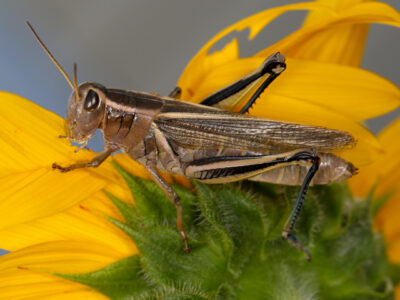Weather opening door to grasshopper invasion
By Justin Sibbet - Lethbridge Herald Local Journalism Initiative Reporter on June 30, 2023.
 Submitted photo by Dan Johnson
A female two-striped grasshopper is seen on a sunflower. U of L professor Dan Johnson says there are pockets of land throughout western Canada that may see significant grasshopper problems as the hot and dry weather continues.
Submitted photo by Dan Johnson
A female two-striped grasshopper is seen on a sunflower. U of L professor Dan Johnson says there are pockets of land throughout western Canada that may see significant grasshopper problems as the hot and dry weather continues.As the hot and dry weather continues, the risk of invasive grasshoppers in southern Alberta multiplying in large quantities increases.
One expert in this field says Lethbridge is looking fairly safe this summer but there are pockets of land throughout western Canada that may see significant problems due to the recent heatwave.
University of Lethbridge professor Dan Johnson, who teaches data analysis, biogeography and environmental science, says there is a common misconception that all grasshoppers are alike.
“They differ in the different regions and the affect crops differently, some of them are not even a problem,” said Johnson.
He says the timing of the regional weather is the most important factor in determining the number of grasshoppers seen annually.
“If you have two or three years of that warm, dry weather at the crucial part of their life, they creep up pretty quickly in numbers,” said Johnson.
While he says Lethbridge’s weather has cooperated in recent years, many parts of the province may struggle with high numbers of invasive species.
“There’s little hotspots all over southern Alberta where they’ve been on the increase.”
He says, while some species do not necessarily migrate, they do spread out as their number increases.
This is aided by mother nature because the reproductive cycle for grasshoppers relies heavily on the aforementioned warm and dry conditions.
“The weather is positive for them in a larger and larger area,” said Johnson.
However, with the large variations in species across Canada, predicting patterns simply based off the weather is not as straightforward as it may originally appear.
“The problem is they’re not the same grasshoppers in different regions,” said Johnson. “So, everyone is a little perplexed about when they’re coming and how to control them.”
Johnson says grasshoppers will survive from the day they hatch, which is commonly around the beginning of June, until they die of the cold weather in or around October.
While urban invasions of grasshoppers are rare, it is not entirely unheard-of.
Johnson pointed out the problems west Lethbridge faced in 2021 as a result of an urban invasion, though he says the regional population has begun to dwindle or even halve each new year since.
The most common victims of grasshoppers are farmers due to their crops being easy targets.
“They don’t poison or anything, they don’t live inside it … they just chew,” said Johnson.
That said, Johnson says certain grasshoppers only eat certain crops, so depending on what is in the area, some farms will be safe.
Even so, he says agricultural advisors recommend farmers check their crops for damages regularly throughout the summer months.
“Don’t guess. Don’t go out and spray if you don’t have them,” said Johnson.
He says, while insecticides typically do work at warding off invasive grasshoppers, they are still not environmentally friendly enough to use regularly.
He says alternative methods are being researched and tested all the time, but it can be a challenge to license those methods.
“We’ve tried hard to develop non-chemical methods,” said Johnson.
Furthermore, he says grasshoppers play an important role in the local ecosystem as they can serve as food for larger animals such as birds.
26-25

